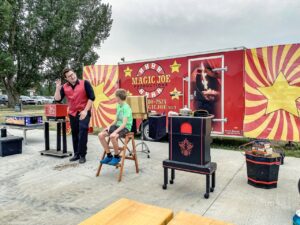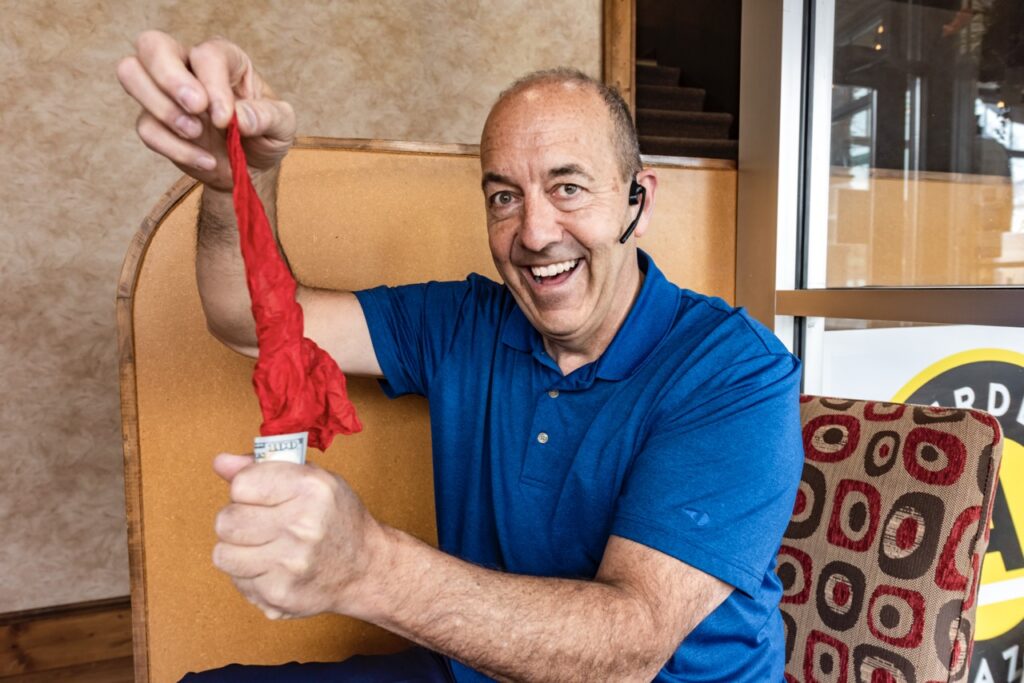

“Every boy likes magic to a certain extent. I just took it a step further.” When Magic Joe Barnett said that, it resonated with me. A budding magician as a kid, I was all about performance and not rehearsal, so my tricks failed, but I remain impressed by and envious of those who do practice and can do magic. Aberdeen is lucky to have a few of them.
Five local magicians (if there are more, maybe they’ve disappeared) told me their stories, if not their secrets, and showed me tricks. For a vocation not known for giving away secrets, there’s a lot of sharing among them. Following Magic Joe’s maxim, all these magicians first got interested as boys.
ORIGIN STORY
Barnett, the man in the middle age-wise, might be the current face of magic in the Hub City. In his mid-30s now, Barnett was turned on to magic at about age 5 when his mom and grandmother took him to see a magician at the Ramkota.
“He wasn’t a big name,” he said, “but it was an awesome show!” The real excitement came after he found his brother’s magic set and its ball vase, a simple trick in which a ball disappears and reappears. “After figuring it out, I took it to preschool, and the kids’ reaction was amazing.” The performing bug bit.
In coming years, he read books and watched videos to learn tricks. As the only one checking out magic books from his school library, the librarian eventually let him keep one.
Largely self-taught, Barnett also learned from Randy Kantack. “I was already deeply into magic by the time I talked to Randy,” Barnett said. “He was definitely a mentor and knew the business aspect. He had a really cool magic room in his basement with a trunk like Houdini’s. He lent me tricks and props.”
Kantack is the most senior of Aberdeen’s illusionists. “I had two uncles who were magicians,” he said. “One followed the old magicians’ code where you don’t show how it’s done. The other taught me a magic trick, and that got me interested.” But the major push came when his kids were in elementary school and wanted him to do a magic show at May Overby. “I only knew a couple tricks, so I bought a videotape, watched it, and did a show with the tricks I learned.”
Former Holgate teacher Kurt Drube had “gotten a magic set as a kid, but I grew out of it.” Then Kantack, who was doing financial work for him, piqued his interest again. “He’d come to the house and do a magic trick before we started the business talk,” Drube said. “Before long, we were meeting just about magic.”
Paying it forward, Drube was instrumental in intriguing the two other magicians. Logan Sibble first became interested in magic at about age 10. He saw a magician at a library in Houston, who did the Chinese linking rings trick.
“I held two large rings separated from each other, and another volunteer held two that were linked,” he remembered. “The magician tapped them and linked mine and undid the others. I was wowed and needed to learn how it was done.” Sibble had Drube as a teacher at Holgate, and “He got me hooked. I did my first performance in the talent show with him. Without Kurt, I wouldn’t be here as magician.”
Brandon Heim remembers receiving a magic kit from his parents and doing a trick for his aunt when he was six. “It worked!” he said. In eighth grade, he watched a TED Talk about misdirection. “I saw the arm twist trick where you get the audience to tie their arms in a knot they can’t untie.” Then he learned how to do it on Google (and worked it on me). That same year, with some inspiration from Drube, he participated in Holgate’s talent show. “As an introvert, I decided to do a big show and did magic. I got a standing ovation that ignited a fire to do magic.” He learned more, and “Everyone knew who I was: the magic guy. I loved the identity that came with it. It gave me a personality when I was an awkward person.”
GIGS
For his first paying gig, Heim got connected with the Aberdeen Downtown Association’s Brent Brandt, who hired him to do street magic for the Wine Walk. “I also opened for a band in Redfield, did a birthday party for a fellow cast member of Hairspray, and performed at Central’s Homecoming.”
Sibble’s first big gig was tragic. “I had a levitating table where you would hold a cloth, and it rose in the air,” he explained. He was performing outside on a blocked off Second Avenue north of the old Red Rooster. “The wind was really rough, and I noticed people pointing behind me.” When he looked, he saw the broken legs of the table of his $700 trick.
Later, he did the Daddy-Daughter dance at CHS. “I did walkaround magic, but it wouldn’t have happened without Joe Barnett.” He remembered, “I got called to principal’s office wondering what I’d done wrong. The principal was stern, acting like I was in trouble, then he let up and offered me the gig.”
Kantack got requests to do shows fairly soon after his May Overby debut, and he “learned that magic needed a presentation.” Involved with Toastmasters, he decided to combine his magic with a speech, which he called Magic with a Message and incorporated a motivational talk.
His biggest gig was in front of 500 people a credit union annual meeting in Aberdeen, and he’s also entertained for conventions here as well as around South Dakota, North Dakota, and Minnesota.
Once he was scheduled to perform for the entire Britton school. When he got there and opened his empty car trunk, he discovered “I’d left my stuff in Aberdeen.” Thinking quickly, he asked the janitor for about 15 items and improvised. He pulled it off and got a standing ovation. “I shared my pay with the janitor,” he added.
Barnett got his first paying gig at about age 10. For a Christmas event in Westport, “Santa canceled so they subbed in a magician,” he said. “I got paid $25.” He also learned some lessons about performing. “I had a trunk with tricks, but I didn’t really have a set list.” After the show, his dad, attorney Joseph Barnett, complimented him but gave a tip: “When someone comes on stage, get the person’s name and say it three times before starting the trick. It gets the person and everyone else to pay more attention.”
Starting with birthday parties for $10, in high school Barnett added corporate gigs, such as Christmas parties, picnics, and grand openings. Now he’s booked most of the summer doing fairs, festivals, and family reunions. He’s done the Brown County Fair, fairs in South Dakota and Minnesota, and the South Dakota State Fair twice. “It’s a true honor to do that,” he said.
At birthday parties, he saws a child in half. “They’re always volunteers who don’t know how it’s done,” he said. But he really likes stage shows. “I like props. They’re very visually appealing. Lots of interesting things on the stage are more intriguing for the audience who wonder what they’ll be used for.” He has a trailer and can set up a stage to do an outside show. His wife Brianna is his assistant, and family vacations often get scheduled around gigs.
MEMORIES
All performers are going to have moments. A memory Barnett might want to forget was at a fair. “I had a prediction box suspended in the air with a prediction inside it,” he said. As he was doing the trick, “I knocked over my case, which knocked over my scrolling sign and caused a mess.” After he regrouped and it was time to reveal the prediction, he couldn’t find the key for the prediction box, which presented the embarrassing problem that “the magician couldn’t break into the lock of his own box!” While cleaning up after the show, he found that the key had gotten trapped inside the sign, which had snapped closed. “The handful of people still around saw that my predictions had been right,” he noted wryly.
Heim, who also had prediction box issues, had a frustrating experience with a successful prediction at a college talent show. Performing after his roommate whose singing wowed the audience, “I did a prediction trick, and everything went perfectly, but I got NO response from the audience,” he lamented. “It was devastating. I nearly quit magic.”
On the other hand, “The CHS homecoming was the best I’ve ever done,” he said and credited Barnett’s help. He performed a trick that involved an outline of a person and a five-foot-tall house. “I had people come on stage and color in the outline with their choice of color,” he said, then, pulling the pieces together, he assembled the house on stage as the audience watched. “I knocked on it a couple times. When I got a knock in reply, my girlfriend at the time lifted up the roof of the house and emerged wearing a costume in the colors the volunteers had created.”
Even more success came when he attended a national swing dancing event in college. “I thought ‘what if I did magic while dancing?’” he said. “So, I pulled a card from one partner’s ear when we danced, then a coin from the next partner.” It was a hit. Returning home, “I did the same at the Red Rooster, and that partner became my wife.”
Impressing peers is, not surprisingly, a source of pride. Kantack’s wife invited Drube to perform magic for her husband’s birthday. “I had been doing a rope routine that I’d never done for people,” he said. “So, I did it then, and it blew Randy away! Randy has commented on how good the trick was, which makes it better.”
One of Kantack’s favorite memories happened when he was pulled over for speeding in Minnesota. As it happened, he was listening to an audiotape on making the best of a bad situation. “I got out of the car and walked to the officer with my hands over my head,” he said. When the officer told him he was speeding, “I produced a hankie out of thin air and wiped my eyes.” After a few more magic tricks, the amused officer went to his car, and “When he returned, he told me he tried to write the ticket, but it magically disappeared.” Kantack smiled, “Magic can get you out of trouble!” The best of a bad situation indeed.
MAKING MAGIC

Magic Joe’s summers are busy with performances across the state of South Dakota. Photo courtesy of Joe Barnett.
Asked for their favorite tricks, Barnett, the magic historian, mentions the cups and balls, “perhaps the oldest trick in world.” In the trick, the performer—sometimes a street magician/con artist—puts a ball under one of three cups, then moves the cups around, sometimes stacking them, and has audience members guess where the ball is—maybe putting money on it—and usually losing. “Many old artworks and posters show a magician doing the cups and balls,” he said, “sometimes with an accomplice pickpocket working the crowd too.” The trick involves so many sleights of hand, “Houdini said all magicians should master the art of the cups and balls.”
Drube’s favorite is the rope routine he developed and debuted on Kantack’s birthday. In fact, “I liked it so much, I didn’t show my proteges how it worked.” It took a year of practice before he performed it. Ropes multiplied, knots disappeared, colors changed. “I still have the rope, but it’s been ten years since I performed it regularly, and it’s hard to recall how I did the trick now.”
A favorite trick of Sibble’s is when a volunteer chooses a card, but as the magician, he produces the wrong one. Momentarily flustered, he then waves the card in the air, and it changes to the correct one. Making an apparent mistake seems to have become a general favorite type of trick, seemingly marking a break from the more formal magicians of a half-century ago. Sibble criticized earlier generations of magicians who suggested they had mystical powers. “New magicians are breaking the mold of older, classic magicians,” he said, debunking some of the conceit.
FLOURISH
Today, only Barnett and Kantack perform regularly. Sibble and Heim have scaled back, interested mostly in small, close-up performances. Drube has mostly retired and, in the spirit of Aberdeen magicians helping each other, “gave most of my stuff to Logan”—although there’s still some “stuff in the basement I couldn’t give away yet,” including that rope trick. The oldest of the magicians, Kantack acknowledged his friend Drube has stepped back, “But I haven’t been able to back out,” he said. “It brings joy to so many people.”
In a similar vein, bringing the story back to the sharing among magicians that’s more common than one might expect, the magic evangelist Barnett commented on a, perhaps, charmed aspect of the shows he does at fairs. “Sometimes the same kids show up over and over again,” he said. “I’ve given them magic tricks and taught them how to do them.” Reflecting on this kind of passing of the magic wand, he said, “feels like recreating my experience watching a magician for the first time.” //



















